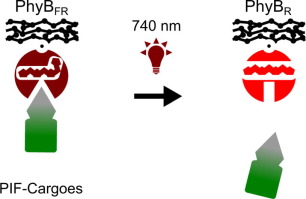Acta Biomaterialia ( IF 9.4 ) Pub Date : 2018-08-28 , DOI: 10.1016/j.actbio.2018.08.032 Hannes M. Beyer , Oliver S. Thomas , Nils Riegel , Matias D. Zurbriggen , Wilfried Weber , Maximilian Hörner

|
Molecular traps can control activity and abundance of many biological factors. Here, we report the development of a generic opto-trap to reversibly bind and release biomolecules with high spatiotemporal control by illumination with noninvasive and cell-compatible red and far-red light. We use the Arapidopsis thaliana photoreceptor phytochrome B to regulate the release of diverse proteins from a variety of material scaffolds. Fusion of a short 100 amino acids “PIF-tag”, derived from the phytochrome interacting factor 6, renders arbitrary molecules opto-trap-compatible. Reversible opto-trapping of target molecules enables novel possibilities for future developments in diagnostics, therapeutics and basic research.
Statement of Significance
The investigation of cellular signaling events or the development of complex therapeutics and integrative diagnostic devices require the deliberate control of biomolecule abundance and activity. During recent years, the use of natural photoreceptors within cells leveraged the control of diverse cellular events, benefiting from the superior spatial and temporal control characteristics of light as compared to conventional chemical stimuli. Concurrently, biological switches entailing intrinsic compatibility toward biological environments increasingly found application in biohybrid materials. We employ the plant red/far-red photoreceptor phytochrome B, which reversibly interacts with its phytochrome interacting factors (PIFs), for developing a generic opto-trap. This platform allows the use of red and far-red light to spatiotemporally control binding and release of arbitrary PIF-fused biomolecules from various material scaffolds.
中文翻译:

泛型和可逆的生物分子光阱
分子陷阱可以控制许多生物因子的活性和丰度。在这里,我们报告了一种通用的光阱的发展,该光阱通过无创且与细胞相容的红光和远红光照明,可逆地结合并释放具有高时空控制能力的生物分子。我们使用拟南芥(Arapidopsis thaliana)感光细胞色素B来调节多种材料支架中多种蛋白质的释放。来自植物色素相互作用因子6的短100个氨基酸的“ PIF标签”融合在一起,可以使任意分子具有光阱相容性。目标分子的可逆光阱捕获为诊断,治疗和基础研究的未来发展提供了新的可能性。
重要声明
对细胞信号传递事件的研究或复杂疗法和综合性诊断设备的开发需要对生物分子丰度和活性的刻意控制。近年来,与常规化学刺激相比,受益于光的优越的时空控制特性,在细胞内使用天然感光体可控制多种细胞事件。同时,要求与生物环境具有内在相容性的生物开关在生物混合材料中的应用日益广泛。我们使用植物红色/远红色感光细胞色素B,可逆性与其植物色素相互作用因子(PIF)相互作用,以开发通用的光电诱捕器。










































 京公网安备 11010802027423号
京公网安备 11010802027423号